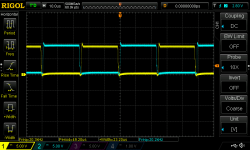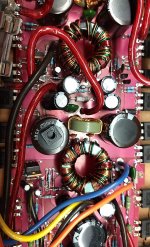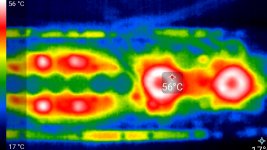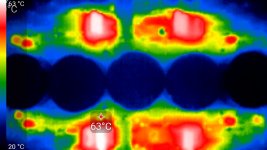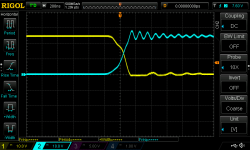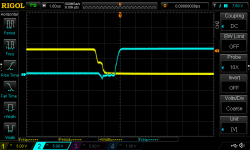Hey folks, I got a pair of nearly new Orion XTR 200's in for repair. The customer said that in both amps idle current takes off after about 15 minutes of idle and he left one of the pair running and it eventually blew it's outputs...
Long story short, I think they went into thermal runaway because both had been removed from their sink prior to testing and both were reassembled with no thermal compound or gap pads to keep the bias diodes in contact with the sink.
Anyhow, my shop is cold and they don't exhibit these symptoms, even after several hours. I believe the highest idle current I saw 2.2-2.6a. What's odd is that the transformers in both amps get much, much hotter than I would expect. I saw temps as high as 90°C. The only other thing that gets even remotely warm at idle are the driver transitors. I've tried twisting and manipulating the transformer, and current draw doesn't change. I've checked the pwm on the ps transistors and they have a good square wave with adequate dead time. At this point I'm thinking that the rail caps are bad, especially knowing the reputation these amps have for cap failure. I'm open to any other suggestions though.
Thank you!
Jason
Long story short, I think they went into thermal runaway because both had been removed from their sink prior to testing and both were reassembled with no thermal compound or gap pads to keep the bias diodes in contact with the sink.
Anyhow, my shop is cold and they don't exhibit these symptoms, even after several hours. I believe the highest idle current I saw 2.2-2.6a. What's odd is that the transformers in both amps get much, much hotter than I would expect. I saw temps as high as 90°C. The only other thing that gets even remotely warm at idle are the driver transitors. I've tried twisting and manipulating the transformer, and current draw doesn't change. I've checked the pwm on the ps transistors and they have a good square wave with adequate dead time. At this point I'm thinking that the rail caps are bad, especially knowing the reputation these amps have for cap failure. I'm open to any other suggestions though.
Thank you!
Jason
Are the PS FETs heating up?
90c at idle is very hot. Since the frequency isn't extreme from what is expected, I'd guess that they used the wrong cores when the transformers were wound. Sometimes when cores overheat badly (there is almost always evidence of it due to discoloration), the core properties can change but since you didn't mention that, I doubt that's what happened here.
90c at idle is very hot. Since the frequency isn't extreme from what is expected, I'd guess that they used the wrong cores when the transformers were wound. Sometimes when cores overheat badly (there is almost always evidence of it due to discoloration), the core properties can change but since you didn't mention that, I doubt that's what happened here.
The amp I measured is the cooler of the pair. I'll check the other in a moment. the PS fets do not seem to get hot, but the amp with the hottest transformers was still in the heat sink. After idling for more than 2hrs though, the heat sink a still cool. The a1306/c3298 driver pairs are the next hottest things in the amp, coming in right around 50 degrees C. The two cores are different colors, but it looks to be factory, not due to heat. I'll edit and attach pics in a moment. they do not appear to have been rewound, or even touched for that matter.
Attachments
Last edited:
The other XTR 200 is the exact same frequency as the other one, 20.3kHz and 20.2kHz. I'm going to let this one idle for a minute, then I'll take a thermal image of it. I can actually smell the enamel on the transformers on this one...
Here are some thermal images of the one in the sink still. It had been idling for about 10 minutes. Shop ambient is probably around 20°. Current draw started at 1.6a and is up to 2.3a. transformers are already up to 65°. Second picture is the overall amp, the last picture is the driver pair.
I'm going to go ahead and check for leaking outputs even though this one is supposedly "new".
Thanks,
Jason
I'm going to go ahead and check for leaking outputs even though this one is supposedly "new".
Thanks,
Jason
Attachments
I believe I may have found the issue. Attached are the waveforms first taken at the mosfet gates, then captured at the primary transformer windings. Not only is it ringing like an old church Bell it also appears that the fall time is to long. I'm going to check for defective pulldowns as well as possible a defective snubber network...
Attachments
If it's too much to warm your shop, why don't you use the blue/pink insulation panels to make a smaller 'room' around your bench? Tape them together with packing tape so you can fold them up like an accordion when not needed. Lay 2 more panels on top of the styrofoam panels to seal the top and prevent heat loss.
I normally have it a bit warmer in here, but I'm out of propane at the moment and it will be a few days before my buddy has time to run my 100lb pig into town with me. I'm just heading with a small electric heater at the moment, but I'll have summer weather in a few days again once he has time to give me a hand.
Ok, I have a question about bias on this amplifier. I finally replicated the original issue that the customer complained of. It is indeed due to the misassembly of the amplifier and the bias diodes not being in contact with the sink. That said, I believe this amp has the bias control on the drivers instead of the outputs. When checking the bias in this design, do you measure across the emitter resistor between the drivers, or still across the output emitter resistors. The bias current on the outputs seems low with only .4mV across the emitter resistors, however, the voltage drop across the driver emitter resistor is just over 1V which seems ridiculously high. I don't believe these drivers should be getting even remotely close to this hot with the amp just idling. All of this bias diodes test ok, and the voltage dropped across the driver emitter drops very rapidly in response to heat applied to the bias diodes, so I believe the circuit is functioning correctly, I just don't understand why the drivers are being hammered so hard with the amp idling.
Thanks,
Jason
Thanks,
Jason
What is the value of the resistor that you're calling the driver emitter resistor?
I think this may be a class B amp so any voltage across the emitter resistors may be too much.
If you think the drivers are running too hot, you can install some clip-on heatsinks.
I think this may be a class B amp so any voltage across the emitter resistors may be too much.
If you think the drivers are running too hot, you can install some clip-on heatsinks.
Perry, the resistor in question is directly across the emitter if the driver pair. It is 39R, 1W. I'm attaching some pictures of the board and the driver area. I apologize, I should have done this sooner. The amplifier looks to be virtually identical to the xtr 100 in the Orion folder.
Thank you!
Jason
Thank you!
Jason
Attachments
Ok, this amp is driving me nuts. I pulled about half the components off the board to clean up the corrosion from leaking caps. I thought I had sorted out the thermal runaway issue and I decided to reassemble and do some more testing. I had the amp idling out of the heatsink for a ages, the only things getting hot were the transformers and the driver pairs. I could not find any issue in the power supply except one of the buffer transistors was a little leaky. I replaced all of them and that cleaned up the waveform at the transformer, but didn't fix how warm they got.
Anyhow, I put it back in the heat sink, and noticed that the main rectifiers no longer made contact with the sink under the board because their foam backing was very degraded. They are mounted directly under the transformers, so I thought maybe they were the reason the transformers appeared to get hot so fast... I replaced the foam and their silpads and got them in goof contact with the sink. I bolted all the outputs down and added silpad and foam tape to keep the bias diodes in contact with the sink. I put it all together and it has the idle current issue again. Before I shut the shop down for the day I decided to monitor the bias on both channels while it was idling to see if there was a correlation between the runaway idle current and the bias.
The bias starts around .4mv on one channel, and nearly 0mv on the other. Once the amp has idled for about a minute, the bias is around 1.1mv on one the higher channel, and .5mv on the other channel. I can heat the area of the clamp bar with hot air and the bias initially drops as expected. If I heat the area for more than a few seconds though both idle current and bias current begin to rise. The low channel stays relatively low, but the higher channel has gotten up to 5mv before I pulled the plug.
I have checked every transistor, resistor, and diode in the poweramp and in circuit they seem to ok. The few odd readings I got, I verified with their mirrored part in the other channel and they checked the same. I'm pretty much at a loss for what is causing this. Especially when a pair of amps are exhibiting the same issues...
Thanks for your thoughts!
Jason
Anyhow, I put it back in the heat sink, and noticed that the main rectifiers no longer made contact with the sink under the board because their foam backing was very degraded. They are mounted directly under the transformers, so I thought maybe they were the reason the transformers appeared to get hot so fast... I replaced the foam and their silpads and got them in goof contact with the sink. I bolted all the outputs down and added silpad and foam tape to keep the bias diodes in contact with the sink. I put it all together and it has the idle current issue again. Before I shut the shop down for the day I decided to monitor the bias on both channels while it was idling to see if there was a correlation between the runaway idle current and the bias.
The bias starts around .4mv on one channel, and nearly 0mv on the other. Once the amp has idled for about a minute, the bias is around 1.1mv on one the higher channel, and .5mv on the other channel. I can heat the area of the clamp bar with hot air and the bias initially drops as expected. If I heat the area for more than a few seconds though both idle current and bias current begin to rise. The low channel stays relatively low, but the higher channel has gotten up to 5mv before I pulled the plug.
I have checked every transistor, resistor, and diode in the poweramp and in circuit they seem to ok. The few odd readings I got, I verified with their mirrored part in the other channel and they checked the same. I'm pretty much at a loss for what is causing this. Especially when a pair of amps are exhibiting the same issues...
Thanks for your thoughts!
Jason
There are 2 chains of 3 4148s for biasing. If you make it 2 chains of 4 4148s. Does that make it better?
Have you measured the DC voltage across all of those 4148s to see if there was a significant difference in the individual diodes?
Have you measured the DC voltage across all of those 4148s to see if there was a significant difference in the individual diodes?
I'll try that, I did test each diode separately and they all looked good. I'll measure voltage drop across the chain of them and see.
Thank you for the idea, I'm running out of things to think of on my own.
Thank you for the idea, I'm running out of things to think of on my own.
I may have been backwards there. You will need to bypass one in each chain. If nothing else, experimenting may help you find a solution.
- Status
- Not open for further replies.
- Home
- General Interest
- Car Audio
- Orion XTR 200 hot transformers
